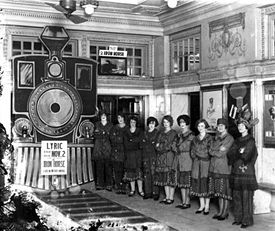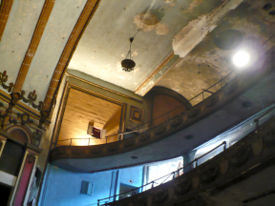Lyric Theatre

The Lyric Theatre is a former vaudeville and movie theater located at 1800 3rd Avenue North on the corner of 18th Street North.
During its peak in the late 1910s and early 1920s, the Lyric hosted major touring shows under the B. F. Keith Big Time Vaudeville banner. In later years the theatre was used for cinema screenings, mostly second-run and alternative releases. It is the only surviving vaudeville theater in Birmingham.
Vacant since the late 1970s, the structure is currently owned by Birmingham Landmarks and fund-raising is underway for an extensive preservation and renovation effort.
History
Opening

The development of the Lyric Theatre began when real-estate developer Louis V. Clark purchased three adjoining lots and hired the Hendon Hetrack Construction Company to construct a six-story office building and theatre on the property. Clark formed a partnership with Jake Wells to operate the theatre. Wells already owned and managed a number of theaters across the South, including the Bijou Theatre a block west.
The Lyric originally had approximately 1,192 seats spread across the main floor and two, steep balconies, plus two opera boxes. A gold-leafed and painted asbestos curtain hung on the stage beneath a proscenium featuring a large mural known as The Allegory of the Muses, which was painted by local artist Harry Hawkins. Beneath the stage are a series of dressing rooms, each about eight square feet with sinks in the corners.
The Lyric opened to the public with a performance headlined by cartoonist Rube Goldberg on January 14, 1914. The opening followed a brief legal dispute with the owners of the Orpheum Theatre for the rights to host shows on the B. F. Keith Big Time Vaudeville circuit. Originally the theater offered a program of seven different acts each week, with three nightly performances and matinees on Saturday. After motion pictures became popular, the Lyric pared its live schedule down to five new acts per week. The theater was closed during the summers.
Heyday
By 1924 the theater was operated by "The Lyric Company", a Dallas, Texas-based enterprise headed by Karl Hoblitzelle. It was affiliated with the Orpheum Circuit, B. F. Keith's circuit, United Booking Offices of America, Hoblitzelle's Interstate Amusement Company, and the Western Vaudeville Manager's Association. W. S. Crosbie was the local manager in charge, wtih Al Plante as musical director of the Lyric Wonder Orchestra. Daily performances were scheduled for 2:30, 7:15 and 9:10, with two matinees (1:15 and 3:15) on Saturdays. Under Hoblitzelle's orders, all performances were guaranteed to be free of offensive words, expressions and situations.
In the early 1920s the Lyric started to see more competition. The Masonic Temple Theater was completed in 1922 and the Ritz and Empire Theaters opened in 1926. Until the completion of the larger air-conditioned Ritz, the Lyric remained the grandest Vaudeville hall in Birmingham. Stars such as Sophie Tucker, Gus Edward's Kid Kabaret with George Jessel and Eddie Cantor, Will Rogers, the Keaton Family Acrobats (with Buster Keaton), Milton Berle, Fred Allen, Jack Benny, Belle Baker, Lottie Mayer's "Neptune Gardens" water divers, Marshall Montgomery, Pat Rooney and Marion Bent, and Mae West appeared on stage.
On Sunday evenings the theatre was used by the newly-formed Independent Presbyterian Church. A Kilgen opus 3459 size 2/4 theater organ was installed in 1925. The touring "A. B. Marcus Revue" held court at the Lyric in 1926 with a large cast and chorus line. The Lyric hosted its own stock dramatic troupes in the off-season, including one with John McFarland and Katherine Comeges as its stars. Russell Filmore's Favorite Players with Jerome Cowan took to the stage in 1927 and 1928. Both groups later moved to the Jefferson Theater.
Decline
The Lyric continued to operate successfully up until the Great Depression. With his funds overextended, Wells lost his chain of theaters and ultimately committed suicide. Ownership of the Lyric reverted to the mortgage company which leased it to the Schubert organization. The Lyric continued to present vaudeville acts, but the Depression and competition from movies and radio led to its decline and closure in 1930 or 1931.
In 1932, brothers Ben and L. A. Stein of Jacksonville, Florida reopened the Lyric as a movie theater. They installed a new Western Electric sound system and other refurbishments and scheduled four feature films each week, beginning with Will Rogers in "A Connecticut Yankee in King Arthur's Court" on April 25 of that year. Ben returned to Florida while his brother remained in Birmingham as manager.
The Lyric received another major renovation with new projection equipment in the early 1940s while Oliver Naylor was manager. In 1945, the Waters family of Birmingham bought the Lyric out of foreclosure for $400,000 and ran it as a second-run movie house. The opera boxes were removed in 1954 under Bill O'Neill's tenure as manager in order to accommodate a 15' tall by 36' wide screen for CinemaScope films. O'Neill also brought back live performances, with a weekly 11 PM "Saturday Night Jamboree" hosted by "Uncle" Jim Atkins and broadcast live on WBRC-AM. Among the musicians taking the stage in the 1950s were Gene Autry and Roy Rogers.
The theatre closed its doors again in 1958. The adjoining office building, however, remained active with businesses such as the House of $8.50 Eyeglasses.
Later life
In 1964 the Women's Committee of 100 studied the possibility of renovating the Lyric as a non-profit civic hall and as a boost to revitalization of the downtown area. The group, headed by Mrs Joseph Simpson, estimated that $150,000 to $300,000 would have to be raised. They incorporated a Lyric Civic Theater Association and hired Nashville architect and theater expert Clinton Brush to advise them on needed repairs and requirements for re-use. The project never materialized.
In 1972, friends and old movie buffs, North Jefferson News editor Dee Sloan and x-ray technician Robert Whorton acquired the theater for a revival house showing pre-1940s pictures. They refurbished the main floor with a red and gold color scheme and new lobby furnishings, including Victorian sofas and a Czechoslovakian chandelier. They reopened as the Grand Bijou Motion Picture Theater with a screening "The Jazz Singer", starring Al Jolson, on April 19, 1973. The feature was preceded by a Keystone Kops short and a 1920s-era newsreel.
The Bijou lasted only a short time. It soon reopened as the Foxy Adult Cinema and later the Roxy Adult Cinema, before closing again for good in the early 1980s. In 1975, the Lyric's twin fire escapes on 18th Street North were populated by bodybuilders posing for the final scene of Stay Hungry.
In 1993, the Waters family donated the building to Birmingham Landmarks, a nonprofit organization which had taken ownership of the Alabama Theatre across the street from the Lyric a few years earlier. Although the theater itself has not been used since the 1970s, the adjoining office building houses operating retail spaces at street-level along 3rd Avenue, including Lyric Hot Dogs and Place Design Studio. The interior is currently in disrepair and has no climate control system, leading to further deterioration. Birmingham Landmarks is currently trying to raise the $20 million that the theater's restoration is estimated to cost.
The City of Birmingham has given $200,000 to study what it would take. In early 2009, Birmingham Landmarks began planning to renovate the lobby to showcase the potential of the theatre's renovation. A few public open-house events were held in advance of the primary fundraising drive to broaden public interest in the venue.
References
- "Lyric to open with pictures" (April 24, 1932) Birmingham News - via Birmingham Public Library Digital Collections
- "Lyric is Old Theater, Yet Very Modern" (October 17, 1945) Birmingham Post - via Birmingham Public Library Digital Collections
- "Lyric Theater to install screen for CinemaScope" (September 21, 1954) Birmingham Post-Herald - via Birmingham Public Library Digital Collections
- "Lyric Theater to present live musical shows" (November 24, 1954) Birmingham Post-Herald - via Birmingham Public Library Digital Collections
- "Lyric restoration boosted as architect takes look" (June 4, 1964) Birmingham News - via Birmingham Public Library Digital Collections
- Weaver, Emmett (June 5, 1964) "Lyric Remodelling Plans Discussed" Birmingham Post-Herald - via Birmingham Public Library Digital Collections
- Keith, Walling (June 22, 1964) "Brighter times at Lyric" Birmingham News - via Birmingham Public Library Digital Collections
- Weaver, Emmett (April 18, 1973) "2 old-film buffs restore the Lyric" Birmingham News - via Birmingham Public Library Digital Collections
- Carter, Lane (April 19, 1973) "Bijou opens with movie great of yesteryear" Birmingham News - via Birmingham Public Library Digital Collections
- "A Lyrical Development." (June 1993) Black & White
- Hollis, Tim (August 16, 2006) "Showplaces of the South, Part 2." Birmingham Rewound. Accessed July 10, 2008.
- Chambers, Jesse (July 3, 2008) "The voice of the theatre." Birmingham Weekly
- Tomberlin, Michael (January 4, 2009) "Push continues for new projects in Birmingham's theater district." Birmingham News
External links
- The Lyric Theatre website
- Photos of the Lyric in the Magic City Flickr Group


